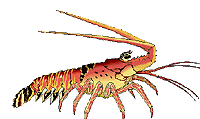|
|
M y children took over my car for a few days and I had the lovely experience of walking along the beach on my way to school. It was lovely since I had the opportunity to say "hi" or stop and chat with a whole lot of friends. It was also a pleasant experience as I witnessed the first day of the lobster season. There were skiffs arriving with coolers and buckets filled with lobster tails and only one skiff with about five hundred whole lobsters. Needless to say I started reminiscing about the lobster season 25 years ago.
My dad along with some 50 other fishermen started constructing their new wooden lobster traps from the day the season closed on March 15. My dad always built 100 and repaired 100 of the previous season, but other fishermen built up to 300 traps.
Four weeks before the season was opened on July 15, the men would soak the traps for several days. This allowed the traps to sink easier with fewer rocks used as sinkers. Three weeks before the season the traps were scattered along one's fishing grounds. The fishing grounds of an individual were marked with poles stuck into the seabed called "valisas." One week before the season, the men would make the first round to check the traps and pull out all the good lobsters. A trap with ten was considered a small catch, 20 okay, 30 very good. If the trap caught very little it was moved to a different spot. My dad said lobsters move during the night in lines and one had to place the trap more or less in their path. This was a matter of luck, of course. The lobsters would then be placed in large box-like containers called "huacales" and hidden somewhere underwater- hidden from possible thieves . or from the fisheries officers who were also considered bandits. These officers would come and with a heavy object smash up the lobster traps or the "huacales" because this was illegal fishing. The lobster could also be placed inside the wire traps or fish traps. There the fisheries officers could not prove that you had caught them illegally because the lobster supposedly went in there by themselves. When this was done, the fishermen had to sleep during the final week on their fishing grounds to keep an eye on their catch.
On the first day of the season, it was like a family day. Dad would need the assistance of the entire family since handling lobsters one by one and putting hem in bags was a painful and laborious experience. So mom and dad were assisted by any sons in the family and at times even by daughters. It was painful, but rewarding. Each bag weighed about 50 pounds and 50 bags yielded 2500 pounds whole lobster. At 8 cents per pound this was $200. Wow! That was a lot of money in the 1950's and some fishermen were known to net 100 bags of whole lobster on one day. Now the lobster purchaser had some men removing the tails and the heads were taken mid-point between the beach and the reef and just dumped there. Sea pollution, I know. But these areas became some of the best fishing spots you could ever find. And if a strong breeze hit, the wave action would bring thousands of lobster heads to the beach. Beach pollution, I know, but there were no tourists back then and the villagers gracefully put up with it, racking it or digging holes and burying the debris. To handle the spiny lobsters, most men used some type of protective gloves. Actually, some who did not ended the day with bleeding hands and not being able to go fishing for a day or two. Now you understand why lobster fishermen had tough hands, perhaps as tough as the hands of the coconut farmers. That I know because my dad paid for my education with lobster dollars, and at times, I had tough hands too.
|
|
|


 On an average in three weeks, my dad (whom I faithfully assisted) had a bout 10 'huacales" with about 300 lobsters in each one or about three thousand lobsters to turn in the first day of the season. This amounted to about 50 crocus bags, In the 1950's my dad sold lobster to private buyers, who resold it in Belize City for about 8 cents per pound whole lobster. Then it went up to 12 cents, 14 cents, and even 16 cents. After a few years the practice went into selling tails only.
On an average in three weeks, my dad (whom I faithfully assisted) had a bout 10 'huacales" with about 300 lobsters in each one or about three thousand lobsters to turn in the first day of the season. This amounted to about 50 crocus bags, In the 1950's my dad sold lobster to private buyers, who resold it in Belize City for about 8 cents per pound whole lobster. Then it went up to 12 cents, 14 cents, and even 16 cents. After a few years the practice went into selling tails only.
